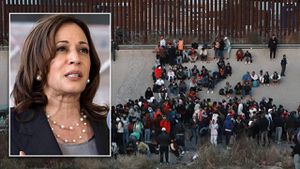The 2024 presidential campaign is shaping up to be one of the most intriguing races yet for the Democratic Party. With the primaries approaching, the dynamics are increasingly defined by key figures like Vice President Kamala Harris and Minnesota Governor Tim Walz, both playing significant roles as the party lays out its strategy to secure the White House amid challenging political backgrounds.
The spotlight was recently on Governor Walz as he made campaign stops across Michigan, including a vibrant rally at The Graduate hotel in East Lansing. This event drew enthusiastic supporters, which underscored the excitement surrounding his candidacy as the Democratic vice-presidential nominee.
At the gathering, Walz advocated for protecting reproductive rights and emphasized the importance of voter turnout, particularly among college students. Notably, he praised Harris’s recent debate performance against Donald Trump, highlighting her competence amid doubts. Commentary from Walz reflected how his campaign aims to resonate with younger voters and marginalized communities, drawing enthusiastic responses from locals.
Participants expressed feeling seen and represented, with one James Madison College freshman, Anabelle Sanchez, stating, “This is a once-in-a-lifetime opportunity...it was such an incredible, unforgettable experience.” Another attendee, Luke Riegel, spoke to the refreshing authenticity of Walz's message, contrasting it with the perceived disconnect of his Republican rival.
Meanwhile, the campaign arena is mirrored by multiple Democratic senators, like Jon Tester and Sherrod Brown, who find themselves on shaky ground. Both senators, known for championing reproductive rights, are treading carefully to navigate the complicated political waters as they gear up for re-election. Notably, Tester—Montana’s lone Democrat holding statewide office—is vying to secure his seat by emphasizing abortion rights, yet he’s refraining from closely linking his efforts with Harris, perhaps due to her mixed popularity.
With the stakes high, Republican efforts are ramping up to undermine these incumbents. For example, Tester has been pushing for Montana’s constitutional amendment to protect abortion rights, but he has deliberately steered clear of endorsing Harris, sensing the risk it could pose to his campaign. Political observers note this reluctance may stem from both Tester’s and Brown’s need to appeal to conservative-leaning constituents, particularly as figures like Trump continue to shape voter sentiments.
While Tester's camp remains cautious, Henry Wilkins, political analyst from Montana State University Billings, argues Democrats are missing opportunities to capitalize on the excitement surrounding Harris's presidential campaign. He asserts there’s potential for broader support if they leverage Harris’s message effectively.
This dynamic has bred accommodations from both Tester and Brown, who hold positions supporting women's reproductive rights but are very careful about how involved they get with Harris's resurgent candidacy. They seek to attract as many voters from across the aisle as possible—maintaining focus on their local issues without overt national politics becoming central to the narrative.
Meanwhile, the advertising war between Democrats and Republicans churns on. Data from AdImpact indicates Democratic spending has exceeded Republican efforts significantly, especially in Montana and Ohio. For every registered voter, Democrats are projected to spend about $300, particularly on ads targeting reproductive rights, whereas their Republican counterparts have invested heavily on inflation and immigration narratives.
Elsewhere, Harris’s influence on the 2024 campaign has sparked mixed reviews. While some observers warn her unpopularity could hurt local candidates, others recognize her message around safeguarding reproductive rights has the potential to unify segments of voters disenchanted with the status quo. Yet, it’s this complexity of perceptions—where economic and personal issues like abortion intersect—that could dictate turnout levels.
A key figure to note within this narrative is Ohio’s Senator Sherrod Brown, another Democrat entrenched in this political theater. Although Brown has kept Harris’s name more present than Tester, his approach maintains focus on the issues at the local level. Brown finds himself relying on his track record with union workers and championing women's rights to set himself apart from his opponent, Bernie Moreno, who has been framing economic concerns, particularly inflation, as the key voter motivator. Moreno’s strategy has included accusing Democrats of misrepresenting his stance on abortion rights, seeking to cast doubt on their efficacy at handling major issues.
Even with this complicated backdrop, grassroots efforts persist, particularly with organizations emphasizing women's rights, such as Red Wine & Blue, which is rallying suburban voters around protective measures for reproductive freedoms. Founder's insights suggest the abortion rights issue has become intrinsically tied to economic debates, reshaping how candidates like Tester and Brown approach discussions during their campaigns.
One poignant moment came during Tester’s recent rally, where he channeled his late mother’s fight for abortion rights, asserting the overturning of Roe v. Wade as “the biggest reduction of freedom” he’s witnessed. The fervor from the local crowd suggested there's still considerable support for candidates willing to publicly engage with these sensitive topics, even as they navigate the restricted messaging around national figures.
Despite the challenges presented by the current political climate, Democrats continue pressing their advantage on reproductive rights, yet it’s painfully clear the road to victory will demand balancing statewide issues with national narratives. Amid complex questions of identity and representation, the outcome of this turbulent election season remains uncertain, fostering speculation and intrigue about which way the winds will blow come November.
With all actors on the battlefield attempting to connect with voters on multiple fronts, the overarching theme of the 2024 campaign is clear: every rally, every speech may be pivotal, potentially reshaping not only the Democratic Party's future but the political fabric of local communities across key states.
Expectations run high for the upcoming debates and political engagements; what lies at stake isn't just the fate of the Democratic Party, but the broader narrative surrounding women's rights, reproductive autonomy, and how these issues intersect with deep-seated economic concerns at every voter’s doorstep.




